Welcome to the WDAS monthly newsletter for February 2016: a digest of the month's latest contributions to our website. Below you'll find Society News, Sky Notes and In-Focus articles printed in full. There's also future events, and trailers for other articles which appear in full on the website - just a click away!
On the website you'll also be able to comment on articles, and if you'd like to play an editorial role in creating new content, just let us know!
Quick Summary for February:
- WDAS Society Meeting on Tuesday 2nd February from 19:30h, including discussions an exciting month's astro news and the latest in the series of talks on the Solar System.
- Star Night at Danby Moor's Centre on Saturday 20th Feburary. Read all the details in the "Events" section. Can you help? Please let Mark know.
Society News
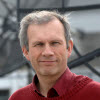
Prof Tom Marsh
(Warwick University)
Delving the depths of white dwarfs, neutron stars and black-holes
Spending the last 15 years doing observations in this field, The objects Tom studies are extremely dynamic and can change within minutes, seconds or even milliseconds. Tom and his team specialise in the high-speed data acquisition and analysis techniques needed to track them. His major project of the last few years has been the use of ULTRACAM, a high-speed CCD camera, but is now working on a successor instrument, bigger and better, with more channels called HIPERCAM.
Tom split the lecture into 4 topics:
- The variable sky
- Timescales
- Observing at high speed
- White Dwarfs and Black holes
The sky is full of variables, for instance the pulsations of variable stars can tell us a great deal about the interiors of stars. The Kepler satellite has carried out a great deal of work in this field; - observing the pulsations of stars. Then there are Gamma Ray Bursts - GRB’s which send out beams of particles. Even cataclysmic variable stars of various types –SS Cygni, and dwarf nova have been monitored by Amateurs for over 100 years.
Tom then went to explain a little bit about Light crossing timescales. For instance, if the Sun switched off instantly it would take 2.3 seconds for it to go dark. The dynamical timescales of various types of stellar remnants, such as a typical White dwarf star, would be around 2 seconds. For a Neutron star of 1.4Msol and radius of 10km, the timescale would be 0.1sec with a similar value for a Black Hole of 10Msol and radius of 30km. So it can be seen that observing any events relating to such objects requires ultra fast observing techniques.
For much of the 1960s, 70s and 80s the choice of the detector to try to capture observations was the Photoelectric Photometer. These were single pixel devices with fixed apertures of around 10 inch. They were extremely limited, picking up less than a quarter of responses.
Post 1985 the instrument of choice was the CCD device, offering a large catchment area;-anywhere from 100 million pixels -3.4 billion. These were very efficient, stable devices, good over all the optical range, but still quite slow when using single frame capture techniques. This led to the ultracam instrument at the end of the 90’s, high speed multi-channel CCD cameras. These employed wavelength dependant reflectors to split light into red green and blue. This was then fitted to the WHT telescope in Las Palmas and also on the VLT in Chile. ULTRACAM can produce lots of data, up to 3 MB per second. Over the course of the night, this can stack up to many gigabytes.
Prof Marsh then went on to talk about White Dwarfs, earth sized remnants of at least 95% of all stars. They are also the powder kegs underlying type 1a supernova. Indeed most of the iron on earth and presumably on many planets is manufactured in this type of supernova. With typical orbital speeds of 400km/s based on 12000km diameter, Prof Marsh have probed the structure of W.D’s using eclipses, often lasting around 30seconds. On this aspect the team are trying to figure out why mass in accreting and non accreting W.D systems is the opposite of expectations. This 3.6MB animated gif shows an area around an eclipsing white dwarf/M dwarf binary called NN Ser during its eclipse. The right-hand panel shows the light-curve. The data were taken with 2 second exposures
Finally Prof Marsh touched on the work being carried out regarding black holes. By using Ultracam on the VLT in Chile, they have been able to measure one candidate is a binary object with a period of 1.8 days and 65 Solar masses.
A fascinating look at how research is undertaken in fields which require split second observations of often very remote objects, adding to our understanding of them.
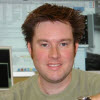
Dr Richard Massey
(Durham University)
Dr Massey’s subject matter was something we have visited several times over the years, what is stuff made of, Chemists would say elements; atoms molecules etc, Physicists would say; muons, quarks, bosons, up and down particles etc. Ask an astronomer and he would suggest 4% baryonic or ordinary matter, 23% dark matter and 73% dark energy!
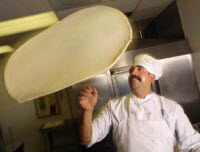 Imagine Pizza dough, said Dr Massey: kneed it, throw it and spin it into a disk. It’s the stickiness of the dough that holds it together and flattens it out into a disk. Galaxies spin around like a pizza with gravity acting as the sticky glue. Back in the 1970’s Vera Rubin however discovered that galaxies were spinning quicker than would be expected with their mass. Some extra, unseen force was at play, providing extra mass. It was also discovered that galaxy groups turning around each other also did not have enough mass to bind them together, yet they plainly were. The mass required for them to remain together was 6 times more than gravity could account for. So the theory of unseen mass ‘Dark Matter’ came about, a term coined by Fritz Zwicky.
Imagine Pizza dough, said Dr Massey: kneed it, throw it and spin it into a disk. It’s the stickiness of the dough that holds it together and flattens it out into a disk. Galaxies spin around like a pizza with gravity acting as the sticky glue. Back in the 1970’s Vera Rubin however discovered that galaxies were spinning quicker than would be expected with their mass. Some extra, unseen force was at play, providing extra mass. It was also discovered that galaxy groups turning around each other also did not have enough mass to bind them together, yet they plainly were. The mass required for them to remain together was 6 times more than gravity could account for. So the theory of unseen mass ‘Dark Matter’ came about, a term coined by Fritz Zwicky.
 Astronomers now believe dark matter filaments were already present in the fledging universe before the formation of any galaxies. Galaxy clusters were in essence bolted to this invisible scaffold. The trouble is how do you detect the invisible? One way is to look for signs of gravitational lensing the field Dr Massey is currently working in. Light rays can be bent by massive objects such as massive galaxies. Using the HST to map the night sky astronomers look for distorted images, signs of the glue holding everything together.
Astronomers now believe dark matter filaments were already present in the fledging universe before the formation of any galaxies. Galaxy clusters were in essence bolted to this invisible scaffold. The trouble is how do you detect the invisible? One way is to look for signs of gravitational lensing the field Dr Massey is currently working in. Light rays can be bent by massive objects such as massive galaxies. Using the HST to map the night sky astronomers look for distorted images, signs of the glue holding everything together.
For the first time however, dark matter may have been caught interacting within a galaxy cluster, Abell 3827, located 1.4 billion light-years away. Although the dark matter cannot be seen, the team was able to deduce its location using the technique of gravitational lensing, bending the path of light passing nearby, in this case from a distant galaxy, which happened to be aligned just right for the team's purpose. When Dr Massey and colleagues previously studied collisions between enormous conglomerations of galaxies, they found that the dark matter hardly slowed down, but in this case they found that one dark matter clump appeared to be lagging behind the galaxy it surrounds. Such a lag between the dark matter and its associated galaxy would be expected if the mysterious stuff was interacting with itself - through forces other than gravity.
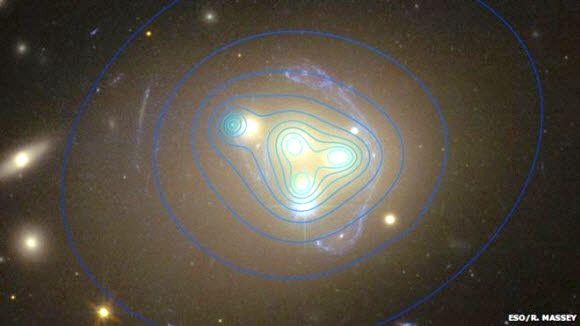
Distribution of dark matter in the cluster is shown with blue contour lines.
Image: ESO/Richard Massey
This slight interaction requires exotic physics, challenging our fundamental theories of particle physics and General Relativity. One potential candidate is the least massive of the (as-yet unobserved) super symmetric particles, and while it is widely believed to be associated with a specific particle, the current theory of physics known as the Standard Model does not account for one, almost all current scientific knowledge concerns only the (few percent) baryons.
Dr Massey did warn that it was too early to say if this is a dark matter effect, or caused by normal astrophysical processes. But it may specify the lower limit of interaction. Simulations will have to be run of these collisions to distinguish these possibilities
Further research by Richard's team has also been published placing an upper limit of the interaction of DM with its surroundings
To further his research, Dr Massey and his team have recently developed and built a new detecting scope called SuperBIT – a low cost solution to perhaps detecting DM particles. Soaring to an altitude around 99% above Earth’s atmosphere, the mission almost ended in disaster when the balloon and instrument package landed less than 30m from a river.
Dr Massey concluded by saying
"We are finally homing in on dark matter from above and below - squeezing our knowledge from two directions."
The Large Hadron Collider will take another approach to cracking the mystery during its second run, which began this month. The giant machine under the French-Swiss border will search for dark matter particles by smashing protons together at unprecedented energies.
The Q&A after Richard's talk was also illuminating. One person from the audience asked whether dark matter could be a new particle. Yes, said Richard: in fact experience shows that particles tend to come in families, so dark matter could consist of a number of new particles. Andi pursued this theme further: could dark matter respond to as-yet undiscovered fundamental forces of nature; and given the ratio of dark matter to barionic matter could there be several families of particles covered by dark matter? Yes, Richard confirmed: we can't rule that out. In spite of the knowledge about dark matter that we're gaining, it's clearly still a deep mystery.

Dr Melvin Hoare
(Leeds University)
The Square Kilometre Array (SKA) project is an international effort to build the world’s largest radio telescope, with eventually over a square kilometre (one million square metres) of collecting area. The scale of the SKA represents a huge leap forward in research and development towards building and delivering a unique instrument and preparations are now well under way.
The original Motivation was to create a map of atomic hydrogen at a specific wavelength of 21 cm at 1 arcsecond resolution out to a redshift of 2 (the minimum area required to achieve this mapping was 1sqkm.) Using existing radio telescopes, currently emission maps have a resolution of only 10 arc seconds achievable out to a distance of redshift - 0.2 The SKA will eventually employ up to 2000 x 15 metre dishes that will enable astronomers to monitor the sky in unprecedented detail. In addition LOFAR will employ a network of over 100 thousand dipole non moveable aerials to study low frequencies, the signals being ‘digitally moved’.
Two sites have been chosen to co-host the radio dishes and antennae, chiefly because of access, remoteness (radio quiet) and atmospheric conditions above the sites. South Africa’s Karoo desert will host the core of the high and mid frequency dishes, ultimately extending over the African continent. Australia’s Murchison Shire will host the low frequency antennas.
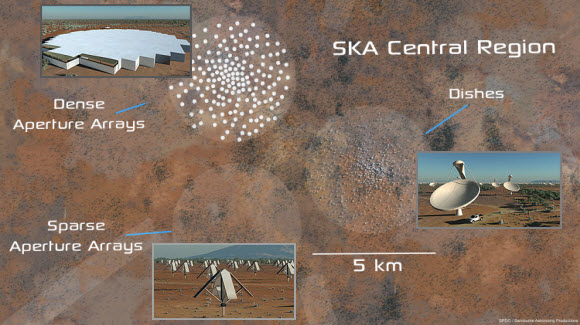
Schematic of SKA Central Region with artists impressions of Dense Aperture Array Station, Low-Band Sparse Aperture Array Station and Offset Gregorian Antennas (dishes).
Ten member countries are the cornerstone of the SKA, but many more are participating in some way. Scientists and engineers are designing and developing a system which uses ultra fast supercomputers, and network technology that will generate more data traffic than the entire Internet.
Due to funding constraints the SKA will be developed over a phased timeline. Pre-construction development started in 2012 and will last until the latter half of this decade. The main bulk of the SKA will be built in two main phases. Phase 1 is already completely funded and will be used in testing the full system in a “proof of concept” manner. Australia will host the low-frequency instrument with more than 500 stations, each containing around 250 individual antennas, whilst South Africa will host an array of some 200 dishes, incorporating the 64-dish MeerKAT precursor telescope due for completion by 2023.
Phase 2 is not fully funded as yet, but will complete the telescope arrays at both sites, and become fully operational by around 2030 (it is hoped) by which time the SKA will count with some 2000 high and mid frequency dishes and aperture arrays and a million low frequency antennas.
Melvin has already been out to Africa to commence training students, 10 or so a year, some of our overseas budget being used for scientific purposes. The SKA will start conducting science observations in 2020 with a partial array.
The headquarters of SKA will be based at Jodrell Bank and it is hoped that eventually redundant dishes in the UK at Goon hilly will be converted and linked into the MERLIN radio dish system, becoming an extension of SKA.
Once completed, the SKA will be able to conduct transformational science, breaking new ground in astronomical observations. These include challenging Einstein’s theory of relativity to the limits, looking at how the very first stars and galaxies formed just after the big bang, in a way never before observed in any detail, helping scientists understand the nature of a mysterious force known as dark energy. They will also study pulsars in proximity of black holes. It will look for signs of planetary formation and ‘micro building block processes’ as well as molecular signatures in the outer regions of proto planetary disks. Exo planet characterizations, low frequency radio emissions from the rotation of planetary/moon magnetics will also be on the agenda. Finally SKA will be used for one of the greatest mysteries known to humankind…are we alone in the Universe, by looking at SETI targets. The SKA will truly be at the forefront of scientific research.

Dr Alan Chapman
(Oxford University)
This was Dr Chapman’s personal homage to Patrick, not his life story as such, but an attempt to compare his likeness with other great science communicators, publishers and educators of the last 300 years.
Alan began in the 17th century, with Dr John Wilkins (1614-1672) a clergyman fascinated by life on other worlds and one of the founders of the Royal Society. In 1638 he had written an account of how you might travel to the Moon on a flying chariot. A man very much in the mould of Patrick, thought Alan. The next successor was Benjaman Martin (1704-1782) a lexicographer who compiled one of the early English dictionaries, the Lingua Britannica Reformata (1749). Was also a renowned lecturer on science and maker and collector of scientific instruments.
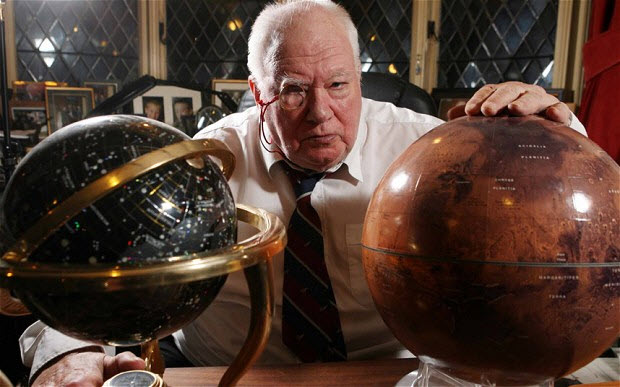
Patrick Moore: Who's he like? ... Like lots of people, says Chapman. Image Credit: Paul Grover
Dr Chapman suggested that both Sir Humphrey Davey (1778-1829) and Michael Faraday (1791-1867) were in some or many ways akin to Sir Patrick. Davey displayed that characteristic enthusiasm and energy in all his pursuits and had a highly imaginative mind, indeed the poet Coleridge declared that if he "had not been the first chemist, he would have been the first poet of his age". At times rather sanguine and of irritable temperament, in spite of his ungainly exterior and peculiar manner, Davey’s gift of exposition and illustration won him extraordinary popularity as a lecturer, his experiments were ingenious. Davey’s dominating ambition, to achieve fame, was certainly opposite of Patrick’s character, however, his frankness and slightly careless observances of etiquette do though bear similarities to Patrick’s nature. Davey’s protégé, Michael Faraday, could be considered more akin to Patrick. Faraday, who contributed so much to various fields in science, was an excellent experimentalist who conveyed his ideas in clear and simple language, not unlike Patrick. The Royal Institute lectures were instigated by Faraday, who in his later life was regarded as what would now be termed a ‘national treasure’. Indeed Queen Victoria granted Faraday a grace and favour apartment at Hampton Court.
Alan’s next choice was Sir Robert Ball, (1840-1913) the genial Irish astronomer and orator, celebrated for his popular lectures on science; bringing science to the masses. He gave an estimated 2500 lectures between 1875 and 1910 in towns and cities across Britain and Ireland lecturing to an estimated one million people, all before the media age. He also delivered three Royal Institute Christmas lectures. Patrick insisted that his grandfather met and knew Ball. Dr Chapman argued that during the early and middle part of the 20th century, the English astronomer, physicist, and mathematician, Arthur Eddington (1882-1944) was the only populariser of Science on a par with Patrick.
Dr Chapman spent the last third of the lecture reflecting on Patrick himself. Alan had come to know Patrick over the course of several decades, through work in the media, on the lecture circuit and many other associated functions, meetings and events. The Moore’s were a military family, indeed Patrick once told Alan he was related to Sir John Moore of Coruna, in the Peninsula wars of the Napoleonic age. Dr Chapman was always a little sceptical of this. Indeed Alan suspected a few of Patrick’s tales and recollections may have been slightly embellished as the years went by. Dr Chapman was even unsure as to the validity of some of Patrick’s war memories he sometimes alluded to. ‘You never quite knew with Patrick’ Alan said.
What cannot be doubted however was the passion Patrick had for astronomy, be it observing, writing about, presenting or giving lectures, Patrick always had something to say – normally very fast. Dr Chapman fondly remembered following his marriage to his wife Rachel in1991, Patrick invited them down to his house; Farthings, in Selsey, for a few days. After dinner on the first night, Patrick decided to do some lunar observing asking Alan to join him. They duly disappeared into the garden leaving Rachel to retire to bed. During the course of the observations, which lasted into the small hours of the morning, they saw a TLP; Trans Lunar Phenomena – a bright streak, perhaps out-gassing of some kind, emanating from near the lunar limb. Such events have been seen occasionally, but to actually witness one with Patrick was something Alan will remember forever.
Patrick was extremely generous, always encouraging, he had time for any young astronomer who wanted his advice. Patrick would spend hours replying to letters and requests in person. Patrick was quite a skilled musician (his mother had been a trained opera singer) and he had learned to play the xylophone. He had a love of cricket, playing in the local team for many years. Alan also saw firsthand the love Patrick had for Cats, and he doted on his own two; Ptolemy and Jeannie who even had their own large self contained run in the garden. Following the death during WW2 of Lorna, Patrick’s only real love, Alan thought ‘they were the children Patrick never had’.
As Patrick’s physical health slowly deteriorated, he found it increasingly difficult to make long journeys, so that eventually the Sky at Night was filmed from Farthings. Alan believed this added a homely feel to the programme which everyone who visited found very comforting. There was always a constant stream of friends and colleagues calling round, even when Patrick became fully housebound, something he hated, he always had time and continued his writings until the end.
Dr Chapman finished by reminding us just how very few people of Patrick’s persona have so endeared themselves to the general public over such a long period of time. Patrick crossed that threshold - observer, presenter, writer, lecturer, national treasure. His like are few and far between.
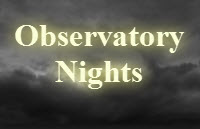 Well, err, mmm, very little to report really, just about every Sunday night has been rained off, clouded out or blown away.
Well, err, mmm, very little to report really, just about every Sunday night has been rained off, clouded out or blown away.
Don’t despair just yet however, we’ve been down this road a few times (unlike the college drive on a Sunday evening) and I’m sure February will bring a change in observing fortunes, either that or snow!
As always if you are intending on coming along if the forecast is better than 50/50, please ring Mark to check beforehand.
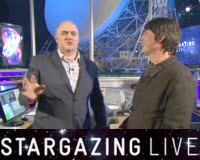 Hope you managed to catch the BBC Stargazing live shows in January. With Major Tim Peake’s stay on ISS already a month old, the emphasis was very much on the work he is doing, astronaut training, and the future direction of manned space flight.
Hope you managed to catch the BBC Stargazing live shows in January. With Major Tim Peake’s stay on ISS already a month old, the emphasis was very much on the work he is doing, astronaut training, and the future direction of manned space flight.
The ‘space walk’ special was particularly informative, especially with Commander Chris Hadfield (the one who sang Space Oddity on the ISS) on hand at Jodrell giving very insightful explanations and opinions.
Chris Lintott’s public science project was also a winner, discovering potential Pulsar signals by trawling through online graph data, looking for the right kind of radio signatures. They were hoping to get a million ‘hits’, they got over 3 million, (over 500 were mine!) with numerous new pulsar candidates being unearthed, one of which was actually picked up by the Lovell radio telescope at Jodrell.
I did feel sorry for the local astronomical society (Macclesfield), who turned out with their scopes each episode, only to be rained off or clouded out. We share their frustrations, one of those Januaries.

